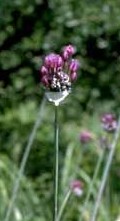 A native of Europe, wild garlic was brought to North America in soil used as ballast in ships. It has become an invasive weed in many parts of the eastern and central United States, particularly where summers are hot and moist, and is also found in parts of the Pacific Northwest. It grows in gardens, lawns, meadows and waste areas along roads as well as in pastures where it can impart its garlic flavor to the meat and milk of the cattle that graze it. It also can taint the flavor of grain crops when they are harvested at the time when the wild garlic is bearing aerial bulblets. Unfortunately, the flavor of Allium vineale has an unpleasant aftertaste so is not desirable as a substitute for garlic.
A native of Europe, wild garlic was brought to North America in soil used as ballast in ships. It has become an invasive weed in many parts of the eastern and central United States, particularly where summers are hot and moist, and is also found in parts of the Pacific Northwest. It grows in gardens, lawns, meadows and waste areas along roads as well as in pastures where it can impart its garlic flavor to the meat and milk of the cattle that graze it. It also can taint the flavor of grain crops when they are harvested at the time when the wild garlic is bearing aerial bulblets. Unfortunately, the flavor of Allium vineale has an unpleasant aftertaste so is not desirable as a substitute for garlic.
 Description: Wild garlic has tall thin grass-like leaves up to two feet long that grow from an onion like bulb. The leaves are round, waxy, and hallow and have a groove on the side facing the stem. The single, unbranched, rounded stem usually bears a cluster of aerial bulbils rather than flowers, some of which may germinate while still on the stem. These aerial bulbils together with the bulblets produced by the onion-like bulb in the soil are wild garlic’s primary means of reproduction. The hallow stem and garlicky smell of all plant parts distinguishes wild garlic from look-alikes such as wild onion, star of Bethlehem, and starch grapehyacinth.
Description: Wild garlic has tall thin grass-like leaves up to two feet long that grow from an onion like bulb. The leaves are round, waxy, and hallow and have a groove on the side facing the stem. The single, unbranched, rounded stem usually bears a cluster of aerial bulbils rather than flowers, some of which may germinate while still on the stem. These aerial bulbils together with the bulblets produced by the onion-like bulb in the soil are wild garlic’s primary means of reproduction. The hallow stem and garlicky smell of all plant parts distinguishes wild garlic from look-alikes such as wild onion, star of Bethlehem, and starch grapehyacinth.

 Control: Control is difficult and removing aerial bulbils and hand pulling may be the best alternatives. Tillage in fall and spring is helpful if repeated for several years. Herbicides are not very effective because of the waxy coating on the stems and leaves.
Control: Control is difficult and removing aerial bulbils and hand pulling may be the best alternatives. Tillage in fall and spring is helpful if repeated for several years. Herbicides are not very effective because of the waxy coating on the stems and leaves.